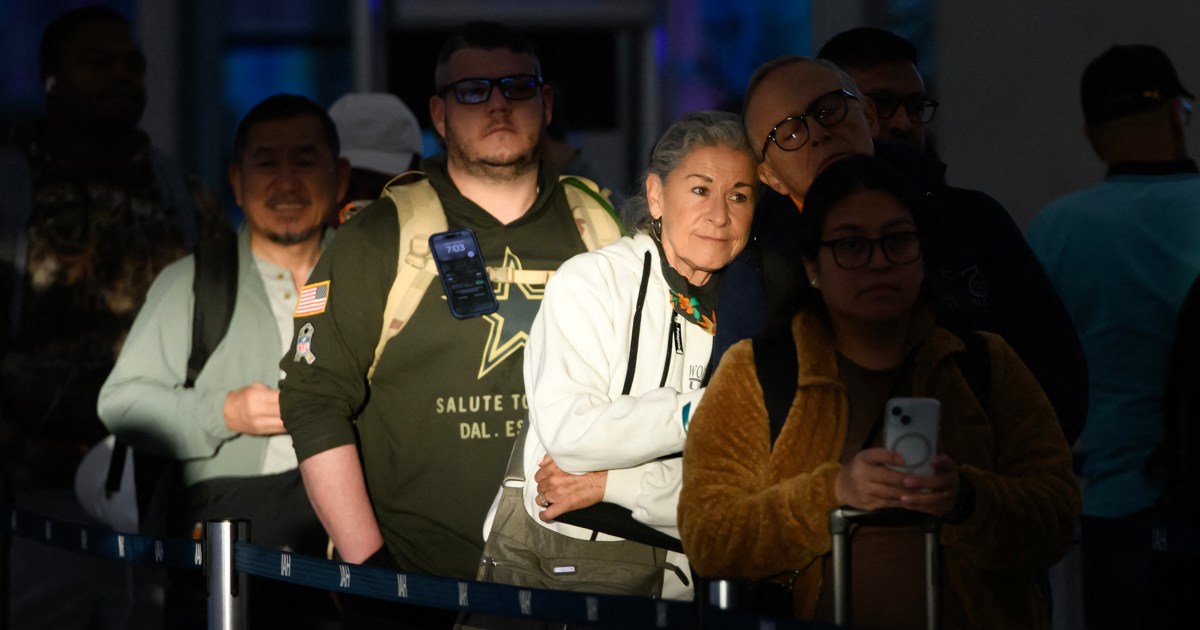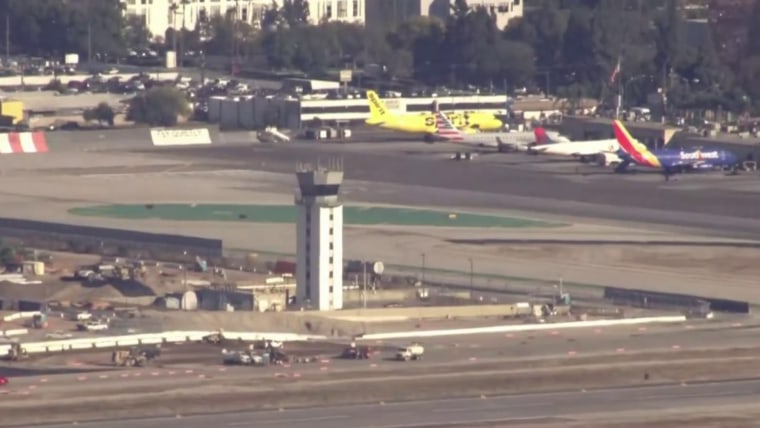
Travelers are bracing for widespread flight delays after the Federal Aviation Administration announced it will begin cutting the number of flights in and out of 40 “high-traffic” airports Friday.
The airports facing a reduction include Chicago O’Hare, Hartsfield-Jackson Atlanta International Airport, Miami International Airport and all three New York-area airports.
The flight reductions will go into effect Friday, which will be Day 38 of the record-long federal government shutdown.
Hundreds of Friday flights had already been canceled by Thursday afternoon, according to the airlines.
American had canceled 220 flights, United 188, Southwest about 100 and Delta 170.
The FAA is requiring 4% of flights to be cut and that will gradually increase to 10% by next Friday.
At Chicago O’Hare, one of the busiest airports in the nation, the 4% reduction will amount to about 23 canceled roundtrip United flights per day.
Omar Idris, the vice president of the United Airlines O’Hare Hub, compared that reduction to “dealing with a minor, minor snowstorm.”
By the time the reduction reaches 10% — the equivalent of about 55 United flights canceled per day at O’Hare — it’ll be similar to dealing with a “decent snowstorm.” Idris said that situation is “not really bad … we can cope with that.”
American said that 220 flights will be canceled each day to follow the 4% reduction.
Unprecedented decision
Jeff Guzzetti, an aircraft accident investigator who has worked for both the National Transportation Safety Board and FAA, said the federal government has never slashed flight capacity across the country like this before.
While the FAA has, in recent months, reduced the number of flights into airports with chronic shortages of air traffic controllers including Newark Liberty Airport, it has never sought to limit traffic in and out of so many airports at once, Guzzetti said.
“The closest comparison would be shutting down the airspace during Sept. 11,” Guzzetti said, referring to the two-day shutdown of the U.S. airspace following the terror attacks in 2001.
FAA Administrator Bryan Bedford said Thursday the move to reduce the number of flights was sparked by “fatigue” plaguing air traffic controllers, who have been working without pay since the start of the shutdown.
Bedford said airports across the country were already contending with staffing shortages before most government operations ground to a halt.
Air traffic controllers are considered essential workers and are not allowed to walk off their jobs. But they’re also exhausted, demoralized and worried about the future, said Nick Daniels, president of the National Air Traffic Controllers Association.
“It’s unprecedented to go through two full paychecks, 37 days, and receive no compensation,” he said. “So it’s not a matter of calling in sick. They’re calling their employer and saying, ‘I don’t have gas. I have not received pay in 37 days. What do you want me to do?'”
Guzzetti said that by slashing flights, the FAA “will reduce potential risk of an overworked controller, or an understaffed FAA facility, from making a mistake and running two airplanes into each other.”
But, said Guzzetti, this “is going to cost the airlines, and commerce, a lot of money. And it will cause massive inconvenience to the traveling public.”
Busy travel period
The cuts, which were announced Wednesday by the Department of Transportation, are taking effect just ahead of Thanksgiving, one of the busiest air travel periods of the year.
Barring a last-minute breakthrough to end the shutdown, the targeted airports will see a 4% percent reduction in flights starting Friday that will continue into the middle of next week, an industry source familiar with the government’s plans told NBC News.
What happens after that is still to be determined, the source said.
Travelers at Ronald Reagan Washington National Airport on Thursday got a taste of the potential havoc to come after the FAA issued an alert warning fliers they could expect delays of 45 to 90 minutes or more due to what it called “staffing” problems.
“I came early because I was concerned about how this shutdown was affecting travel,” traveler DeKerry Davis said.
What Davis found at the airport was, in a word, “awful.”
In addition to flight delays, Davis said American Airlines passengers were hit with computer glitches that made it impossible for them to print boarding passes.
“I wish they would figure it out and get it fixed,” Davis said.
At LaGuardia International Airport in New York City, 26-year-old Jon Pax said he feared he might not fly out in time to catch the connecting flight in Chicago to his home in Madison, Wisconsin.
Pax said he might have to rent a car to avoid being stranded. And he’s already rethinking his travel plans for getting to Cleveland for Thanksgiving.
“We’re gonna drive from Wisconsin to Cleveland, which is normally a quick flight, but it’s gonna be an eight- or nine-hour drive instead,” Pax said.
Pax expressed sympathy for the hard-pressed controllers and TSA employees working without pay.
Lawmakers, Pax said, need to “figure it out.”
“Especially as the shutdowns extend and become longer and longer, it just puts so much more of a financial strain on people, right?” Pax said. “In an ideal world, everyone has their six-month emergency fund and whatever, but that’s just not the case in today’s day and age.”
Michelle Travis, 59, was flying home to San Antonio with her daughter Thursday afternoon and her departure time had already been pushed back 20 minutes.
Travis said what’s going on at the airports is absolutely factoring into their holiday plans.
“We were considering flying to Florida and/or driving, and for sure, now we’re driving for Thanksgiving,” Travis said.
For Andy Ademe, 35, the shutdown is adding more stress around airline travel.
“I had some hesitancy about flying out for this business trip, because I’m actually going on vacation with my family tomorrow,” Ademe said. “So I’ve already had an hour of delays today, not related to the shutdown, just mechanical, but it’s definitely been a concern of mine.”
Questions around airline earnings
The airlines had been hoping to build on the momentum that led to a successful third quarter, but now it’s uncertain whether the year-end forecasts will weather the current political storm.
United Airlines reported that its third quarter, which ended in September, exceeded expectations, with operating revenue growing 2.6% year over year to $15.2 billion. It boasted that the company could thrive in an “economically volatile year.”
United said it expected the end of the year to “have the highest total operating revenue for a single quarter in company history,” according to a press release.
But in an Oct. 16 earnings call, United CEO and Director J. Scott Kirby told shareholders that he was not sure how the shutdown would affect the business.
“Every day that goes by, the risk to the U.S. economy grows,” Kirby said. “So I hope we will avoid an unforced error here.”
At the start of the shutdown, Delta Air Lines reported on its earnings call a record September-quarter revenue of $15.2 billion.
Delta President Glen William Hauenstein said, at the time, the airline still anticipated revenue growth of 2 % to 4% for the December quarter.
American Airlines was also optimistic, in the early days of the shutdown, that it would quickly recoup its losses, which at the time amounted to less than $1 million a day in revenue.
CEO Robert Isom said on his earnings call 23 days into the shutdown that he was in “constant contact” with Transportation Secretary Sean Duffy.
“So the impact, while it’s there, is something that I’m quite confident when the government reopens, there’s going to be some pent-up demand,” Isom said. “And hopefully, we get back on track pretty quick.”

Reducing flights a ‘proactive’ measure
The targeted airports were chosen based on data, including voluntary safety disclosure reports from commercial air transport pilots that revealed fatigue-related pressure points, the FAA said.
Bedford described the FAA action as “proactive.” Should the shutdown end soon, Bedford said, the cuts would end when there’s a “return to controller performance” at pre-shutdown levels.
Should things worsen, Bedford said, additional measures could be taken in specific markets.
Delta said in a statement Thursday that it “expects to operate the vast majority of our flights as scheduled, including all long-haul international service, and will work to minimize customer impact while keeping safety our top priority.”
Delta said it would provide “additional flexibility” to passengers, including the ability to change, cancel or refund flights with no extra charge.
American Airlines offered customers a similar option to change their flight or request a refund without any penalty. The airline said in a statement Thursday that the “vast majority” of travel will be unaffected, but it will reach out to those affected.
Disrupting plans is “the last thing we want to do,” American Airlines said.
“In the meantime, we continue to urge leaders in Washington to reach an immediate resolution to end the shutdown,” the statement added.
Where will flights be cut?
- ANC — Anchorage International
- ATL — Hartsfield–Jackson Atlanta International
- BOS — Boston Logan International
- BWI — Baltimore/Washington International
- CLT — Charlotte Douglas International
- CVG — Cincinnati/Northern Kentucky International
- DAL — Dallas Love Field
- DCA — Ronald Reagan Washington National
- DEN — Denver International
- DFW — Dallas/Fort Worth International
- DTW — Detroit Metropolitan Wayne County
- EWR — Newark Liberty International
- FLL — Fort Lauderdale–Hollywood International
- HNL — Honolulu International
- HOU — William P. Hobby (Houston Hobby)
- IAD — Washington Dulles International
- IAH — George Bush Intercontinental (Houston)
- IND — Indianapolis International
- JFK — John F. Kennedy International (New York)
- LAS — Harry Reid International (Las Vegas)
- LAX — Los Angeles International
- LGA — LaGuardia (New York)
- MCO — Orlando International
- MDW — Chicago Midway International
- MEM — Memphis International
- MIA — Miami International
- MSP — Minneapolis–St. Paul International
- OAK — Oakland International
- ONT — Ontario International
- ORD — Chicago O’Hare International
- PDX — Portland International
- PHL — Philadelphia International
- PHX — Phoenix Sky Harbor International
- SAN — San Diego International
- SDF — Louisville International
- SEA — Seattle–Tacoma International
- SFO — San Francisco International
- SLC — Salt Lake City International
- TEB — Teterboro (New Jersey)
- TPA — Tampa International
CORRECTION (Nov. 6, 2025, 2:16 p.m. ET): An earlier version of this article misstated the length of the shutdown. Friday would be the 38th day, not the 37th.
Kate Reilly is a news associate with NBC News.
Doha Madani is a senior breaking news reporter for NBC News. Pronouns: she/her.
Jay Blackman
Jay Blackman is an NBC News producer covering such areas as transportation, space, medical and consumer issues.

Tom Costello
Tom Costello is an NBC News correspondent based in Washington, D.C.
Corky Siemaszko
,
Marlene Lenthang
and
Katie Taylor
contributed
.